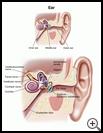
Hearing Tests
________________________________________________________________________
KEY POINTS
- A hearing test is a way to check your child for hearing loss. Your child may have different tests to check for different types of hearing loss.
- Your child may have a hearing test during a regular checkup. If your child has symptoms, such as trouble hearing or ear pain, see your healthcare provider to have your child’s hearing checked.
________________________________________________________________________
What is a hearing test?
A hearing test is a way to check for hearing loss. All babies have their hearing checked before leaving the hospital after birth. Preschool and school-age children may have their hearing checked at school or during well-child visits.
See your healthcare provider if your child had symptoms such as:
- Having trouble hearing conversations when in a group or there is a lot of background noise
- Feeling ear pain when around loud noises
- Hearing sounds as muffled, but thinking his or her own voice sounds louder than normal
- Having trouble understanding women and children who have higher pitched voices
- Hearing nothing in one or both ears
- Having ringing in one or both ears (tinnitus)
What happens during a hearing test?
The most common test is called a pure-tone test. Soft tones are played at different pitches from low to high. When your child hears a tone, your child may be asked to raise a finger, press a button, or say yes. If your child has trouble hearing some of the tones, your child may be referred to a hearing specialist (audiologist) for further tests to find out:
- How much of a hearing loss your child has, and if it's in one or both ears
- Possible causes of the hearing loss
- Possible treatment options
There are different types of hearing loss:
- Conductive deafness happens when sound waves are blocked as they pass through the outer or middle ear. The most common cause of conductive deafness is earwax. Other causes include ear infections, a tear or hole in your eardrum, or damage to the small bones in the middle ear that conduct sound waves. Otosclerosis is a type of conductive hearing loss. It may be caused by viruses or hormones, or it may be inherited.
- Nerve-related hearing loss happens because of a problem in the inner ear (cochlea) or in the nerve that connects the inner ear to the brain. It is the most common form of hearing loss.
- Central deafness is due to a problem in the hearing centers of your child’s brain. Central deafness may follow a long illness with high fever, a head injury, or stroke. It can also be caused by a tumor.
Your child may have different tests to check for different types of hearing loss. For example:
- Tympanometry is a measure of the stiffness of the eardrum and middle ear. This test can check for fluid in the middle ear, problems with the small bones in the ear, a hole in the eardrum, and otosclerosis. For this test, a soft probe is put into your child’s ear canal and a small amount of pressure is applied. The probe then measures how the eardrum responds to pressure changes.
- Acoustic reflex threshold testing uses a loud sound to check if the muscles in the middle ear contract. This is a reflex that decreases the volume sent to the inner ear. The audiologist increases or decreases the volume to find the level at which this reflex happens. This test checks for problems with the nerves.
- A Rinne test uses a tuning fork placed on the bone behind one ear. Your child signals when he or she no longer hears the sound. Then the tuning fork is moved outside the ear canal. Your child again signals when he or she no longer hears the sound. If your child’s hearing is better using bone than air, this suggests a conductive hearing loss.
- MRI uses a strong magnetic field and radio waves to check for acoustic neuroma, which is a tumor that grows on the cells that wrap around the main nerve in the inner ear.
Last modified: 2020-01-14
Last reviewed: 2020-01-13

